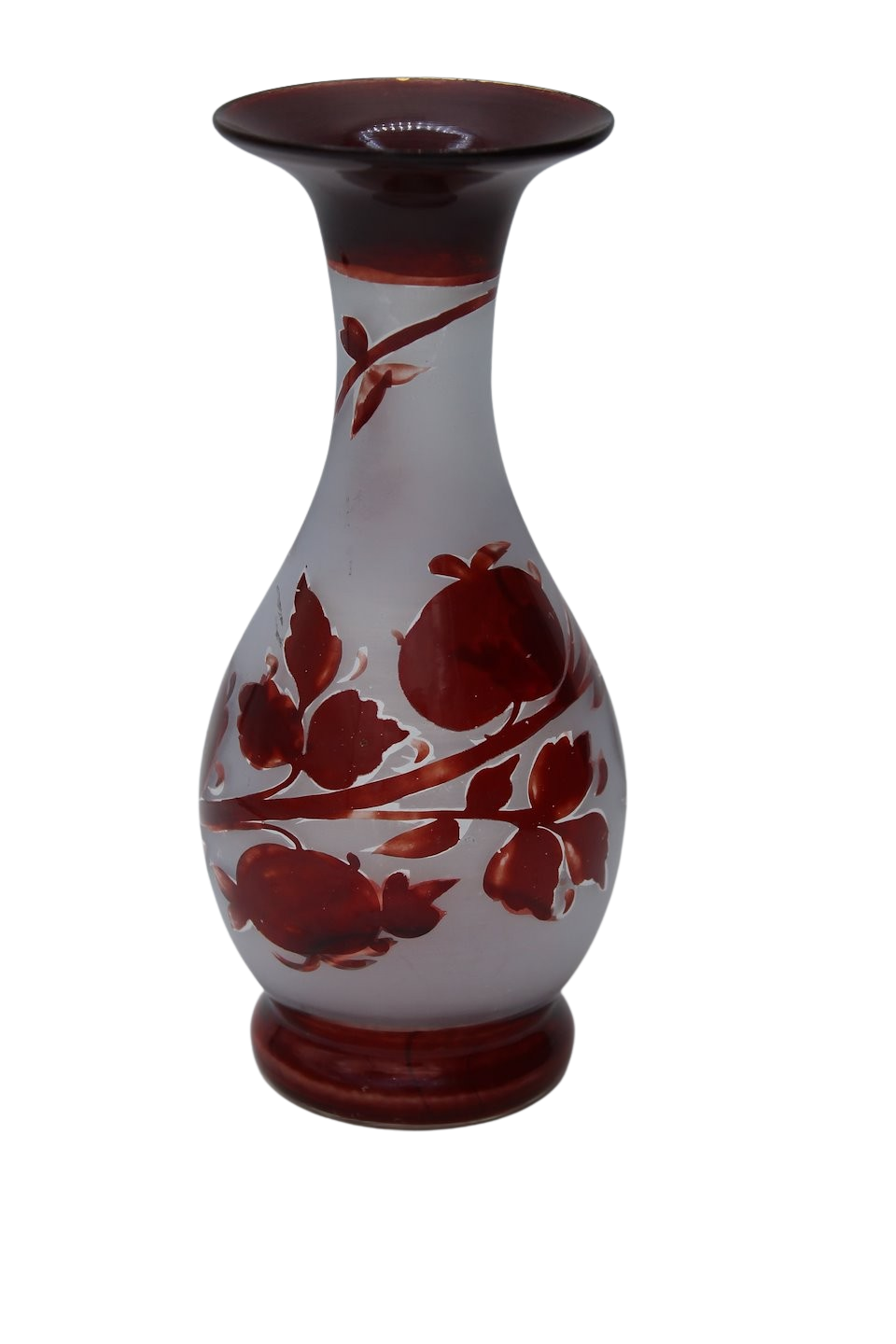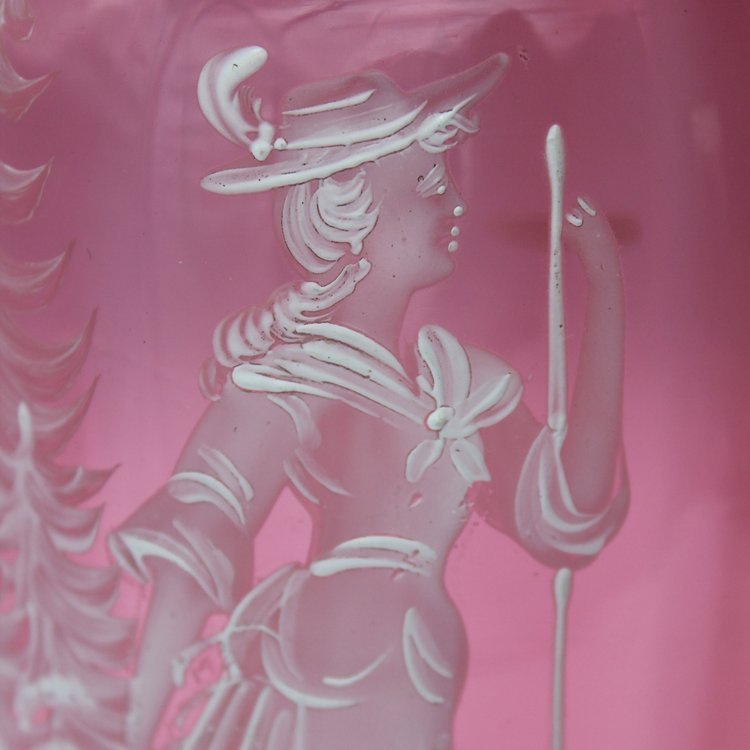
Ruby and Cranberry Glass
Glass decorating techniques and an ode to red
Peggy Woodrow tended to collect glass in two shades of red
Advances in technology in the 19th century made glass more affordable and more widely available. Most of the pieces in Peggy’s collection are from the late 1800s.
Glassmaking and glass decoration still used some ancient techniques, combined with new ways of making, colouring, and decorating glass. Many of them were influenced by styles from Bohemia, a region with a long glass-making tradition in what is now the Czech Republic.
Various coloured glass pieces. Shown in further detail and identified below.
Peggy’s collection provides a glimpse into the many ways that glass is decorated, and into her collecting sensibilities.
Cranberry glass decanter with clear glass stopper and handle. Circa 1850s. 25 cm tall. 2006.310.1
Cranberry glass is pinkish-red.
Most of Peggy’s red glass is cranberry.
She collected candy dishes, lanterns, and decanters. She also owned a small selection of Mary Gregory glass.
Two ruby flash (?) glass decanters with stoppers. Circa 1880s. 22 cm tall. 2006.320.1 (left) and 2006.321.1 (right).
Ruby glass is a deep, dark shade of red made by adding gold to molten glass.
Ruby glass has been a popular collectible for over a century.
Newer ruby glass is coloured with selenium or copper using processes developed in the early 20th century.

Glassmakers jazzed up these pieces with additive and subtractive techniques.
They created surface decoration by adding glass in molten or paint form or removing glass by etching it away.
This exhibit focuses on surface decoration, but we invite you to consider form as well. How do the shapes of these pieces interact with their surfaces?
Ruby flash glass vase with applied raised snake and cut-to-clear (?) botanical motifs. Circa 1880s. 25 cm tall. 2006.317.1
Technique 1: Ruby Flash
Ruby flash is clear glass coated in ruby glass. A clear glass base piece is formed into its final shape, then dipped in ruby glass.
This technique is often associated with Bohemian glass.
Cut-to-clear removes flash to create surface decoration.
The flash surface is etched away to reveal the clear glass underneath, allowing makers to form elaborate patterns.
Cranberry glass bonbon dish with smooth marbled milk glass stripes and fluted edges. Circa 1860s. 9 cm tall. 2006.303.1d
Technique 2: Trailing
Trailing uses thin threads of hot glass applied onto the surface of a piece to create decoration.
This marbled surface was likely achieved first with trailing, followed by smoothing and pulling or combing of the threads.
Pair of ruby glass vases with white and gold enamelled leaves. Circa 1880s. 15 cm tall. 2006.315.1 (left) and 2006.315.2 (right)
Technique 3: Glass Paint
Vitreous enamels are powdered glass made into paint.
They are painted and then fired onto the surface of the glass.
This method of decoration originated in ancient Egypt.
Both form and decoration can be used to create interest
“Mary Gregory,” or “Quarkman,” glass originated in 19th century Bohemia.
Typical Quarkman pieces use white enamels on coloured glass to depict children in outdoor scenes.
The result resembles cameo glass—a form of carved glass art that was first made in ancient Rome—without the need for complicated carving.
Detail of 2006.322.19
This glass has no relationship to anyone named Mary Gregory.
Though Mary Gregory appears to have been a real woman who worked as a glass decorator, she did not create this style of glass. The name likely came from the Westmoreland Glass Company, who used it in their marketing in the 20th century.
Cranberry glass Mary Gregory vase depicting a woman with a walking stick. Date unknown. 26 cm tall. 2006.322.19
Fine Mary Gregory glass uses white-on-white enamels to simulate depth.
Layering enamels creates intricate detail and requires multiple firings. Before WWII in Bohemia, enamels in this style were applied by decorators of German ancestry. Fathers passed the technique down to their sons, some of whom began painting by the age of 10.
This style was made both pre-and post-war. Post-war pieces are likely not from Bohemia.
The take-away technique, developed after WWII, helped simplify the painting process.
Pair of cranberry glass Mary Gregory salt dishes depicting a boy reaching for a bird and a girl blowing bubbles. Circa 1970s-1980s. 6 cm tall. 2006.322.17 (left) and 2006.322.16 (right)
Detail of 2006.322.16
This technique is only present in post-war pieces. After WWII, German decorators were expelled from the Czech Republic. Czech glassmakers had to become decorators.
Instead of layering enamels to create detail, they applied thick, opaque enamels and wiped them away to create negative-space details. This less-elegant method is less desirable to collectors.
Cranberry candy dishes with clear glass stems and bases. Circa 1860s. 12-14 cm tall. 2006.307.1b (left) and 2006.307.2a (right).
These pieces come from two different sets of two.
Cranberry glass lantern with swirled body and clear glass chimney. Circa 1875. 22 cm tall. 2006.313.1
Peggy’s collection shows her appreciation for red glass, and for the varied – and similar – forms it can take.
While these pieces show a variety of decoration techniques, many come from matching sets, whether designed and sold in sets by the makers or collected in pairs by Peggy. Her candy dishes and vases often come in matching pairs.
Cranberry glass decanter with swirled body and pewter top/handle. Circa 1850s. 31 cm tall. 2006.311.1


















